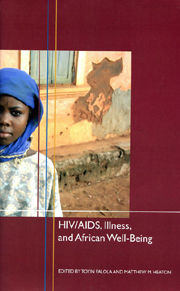Book contents
- Frontmatter
- Contents
- Acknowledgments
- Part I Context
- Part II Illness Case Studies
- Part III Globalization, Development, and Health
- Part IV HIV/AIDS
- 12 Of Savages and Mass Killing: HIV/AIDS, Africa and the Crisis of Global Health Governance
- 13 Vicissitudes of AIDS Policies in Burkina Faso from 1985 to 2001: A Historical Perspective
- 14 Factors Associated with Deliberate Attempts to Transmit HIV Infection among Persons Living with HIV/AIDS in Tanzania
- 15 Development and Alternative Mitigation Treatment Opportunities of the HIV/AIDS Epidemic
- 16 Confusion, Anger, and Denial: Results of HIV/AIDS Focus Group Discussions with Urban Adult Zimbabweans
- 17 Three Proposals for Analyzing the Economic Growth Effects of HIV/AIDS in Sub-Saharan Africa
- List of Contributors
- Index
- Rochester Studies in African History and the Diaspora
17 - Three Proposals for Analyzing the Economic Growth Effects of HIV/AIDS in Sub-Saharan Africa
from Part IV - HIV/AIDS
Published online by Cambridge University Press: 05 February 2013
- Frontmatter
- Contents
- Acknowledgments
- Part I Context
- Part II Illness Case Studies
- Part III Globalization, Development, and Health
- Part IV HIV/AIDS
- 12 Of Savages and Mass Killing: HIV/AIDS, Africa and the Crisis of Global Health Governance
- 13 Vicissitudes of AIDS Policies in Burkina Faso from 1985 to 2001: A Historical Perspective
- 14 Factors Associated with Deliberate Attempts to Transmit HIV Infection among Persons Living with HIV/AIDS in Tanzania
- 15 Development and Alternative Mitigation Treatment Opportunities of the HIV/AIDS Epidemic
- 16 Confusion, Anger, and Denial: Results of HIV/AIDS Focus Group Discussions with Urban Adult Zimbabweans
- 17 Three Proposals for Analyzing the Economic Growth Effects of HIV/AIDS in Sub-Saharan Africa
- List of Contributors
- Index
- Rochester Studies in African History and the Diaspora
Summary
Not since the bubonic plague in the fourteenth century has there been an infectious disease as devastating as HIV/AIDS. While the epidemic is worldwide, the overwhelming majority of its impacts currently are in sub-Saharan Africa. In some of these societies, a third or more of adults in their economically active prime (age fifteen to forty-nine) are HIV positive. Contrary to beliefs held by many that this is an affliction of the destitute, HIV/AIDS in Africa is remarkably egalitarian. Indeed, in some cases infection rates are higher among highly trained workers, such as teachers, health-care workers, miners, and truckers, than in the general population. Given this, the impact of the epidemic on economic growth in sub-Saharan Africa should be readily detectable and markedly negative.
Certainly there are numerous studies of specific countries or industries in specific countries that point to the disease's negative effects. These studies primarily employ economic engineering or simulation approaches for determining HIV/AIDS' impact. Current and projected infection rates among workers are estimated and based on these studies; treatment and training costs and occasionally values of lost production are calculated. In such studies, it is assumed that all adjustment mechanisms are captured by the researchers' models. For processes as complex as an economy's reactions to an epidemic, clearly, this is not the case. No researcher, a priori, can know, for example, to what extent less labor-intensive crops will be resorted to if agriculturalists sicken or if shifts would be primarily to more capital-intensive approaches for producing the same crops.
- Type
- Chapter
- Information
- HIV/AIDS, Illness, and African Well-Being , pp. 386 - 402Publisher: Boydell & BrewerPrint publication year: 2007



